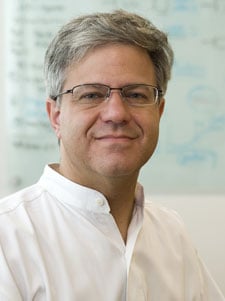 |
|
| Phillip D. Zamore, PhD |
Phillip D. Zamore, PhD, a pioneer in the study of RNA silencing, also called RNA interference, was named a 2014 Fellow by the National Academy of Inventors (NAI). The NAI awarded the distinction of Fellow to 170 esteemed innovators and inventors today. This brings the total number of fellows, representing more than 150 prestigious research universities and governmental and non-profit research institutions, to 414.
Election to NAI Fellow status is a high professional distinction accorded to academic inventors who have demonstrated a prolific spirit of innovation in creating or facilitating outstanding inventions that have made a tangible impact on quality of life, economic development and the welfare of society. The academic inventors and innovators elected to the rank of NAI Fellow are named inventors on U.S. patents and were nominated by their peers.
Dr. Zamore, the Gretchen Stone Cook Chair in the Biomedical Sciences and professor of biochemistry & molecular pharmacology at UMass Medical School; a Howard Hughes Medical Institute Investigator; and co-director of the RNA Therapeutics Institute, is credited with identifying the biochemical machinery responsible for RNA silencing, the mechanism through which small pieces of genetic material can turn specific genes on or off. Among his many discoveries, he showed how short segments of RNA act as guides during the silencing process, ensuring that the targeted gene is silenced.
Recognizing the power of RNAi as a research tool, scientists quickly began applying this knowledge in the lab, silencing genes one-by-one to determine the function of the proteins they produced. Now, researchers around the world are investigating the therapeutic power of RNAi, testing its ability to block the action of genes that have gone awry in diseases. Working with his UMMS colleagues, Zamore is using RNAi technologies to help design a therapy for Huntington’s disease, a devastating neurodegenerative disease caused by one defective gene on a single chromosome. The hope is that small interfering RNAs can be used to selectively turn off the defective gene without harming the healthy gene on the other chromosome, which is needed for survival. He began the work after UMMS colleague Neil Aronin, MD, professor of medicine and cell & developmental biology, asked for his help in developing a treatment that shuts down the Huntington’s gene.
Zamore continues his work combining biochemistry with genetics and cell biology to understand the biological functions and the molecular basis of the RNAi pathway; specifically his team has found that small RNAs—a class that includes small interfering RNAs, microRNAs, and Piwi-interacting RNAs—contain many layers of information that guide the gene-silencing process. The RNA sequence on the molecule specifies not only which gene will be silenced but also how that silencing will occur.
A member of the UMMS community since 1999, Zamore received his AB (1986) and his PhD (1992) from the Department of Biochemistry and Molecular Biology at Harvard University and was awarded a Life Sciences Research Foundation Fellowship to complete his post-doctoral study at the Whitehead Institute at the Massachusetts Institute of Technology. Since joining UMMS, he was named a 2000 Pew Scholar in Biomedical Sciences by the Pew Charitable Trusts and, in 2002, was appointed a grant recipient under the W. M. Keck Foundation’s Distinguished Young Scholars in Medical Research Program. In 2008, he was named a Howard Hughes Medical Institute Investigator, one of the most prestigious and sought-after scientific designations in the world. In 2009, he was the recipient of the Schering-Plough Award from the American Society for Biochemistry and Molecular Biology.
Prior NAI fellows from UMass Medical School include: Robert H. Brown Jr., DPhil, MD, the Leo P. and Theresa M. LaChance Chair in Medical Research and chair and professor of neurology; Roger J. Davis, PhD, Howard Hughes Medical Institute Investigator, the H. Arthur Smith Chair in Cancer Research and professor of molecular medicine and biochemistry & molecular pharmacology; Nobel Laureate Craig C. Mello, PhD, Howard Hughes Medical Institute Investigator, the Blais University Chair in Molecular Medicine and distinguished professor of molecular medicine and cell & developmental biology; and John E. Ware, PhD, professor of quantitative health sciences.
The NAI Fellows will be inducted by the Deputy U.S. Commissioner for Patent Operations, from the United States Patent and Trademark Office (USPTO), during the 4th Annual Conference of the National Academy of Inventors, on March 20, at the California Institute of Technology in Pasadena.
Fellows will be presented with a special trophy, newly designed medal and a rosette pin in honor of their outstanding accomplishments. To honor these academic luminaries of invention and innovation, a plaque listing the name and institution of each NAI Fellow will be on permanent display at the USPTO. The 2014 NAI Fellows will be recognized with a full page announcement in The Chronicle of Higher Education Jan. 16 issue, and in upcoming issues of Inventors Digest and Technology and Innovation.
Included among all of the NAI Fellows are 61 presidents and senior leadership of research universities and non-profit research institutes, 208 members of the other National Academies (NAS, NAE, IOM), 21 inductees of the National Inventors Hall of Fame, 16 recipients of the U.S. National Medal of Technology and Innovation, 10 recipients of the U.S. National Medal of Science, 21 Nobel Laureates, 11 Lemelson-MIT prize recipients, 107 AAAS Fellows, and 62 IEEE Fellows, among other awards and distinctions.
The 2014 NAI Fellows Selection Committee comprises 17 members, including NAI Fellows, recipients of U.S. National Medals, National Inventors Hall of Fame inductees, members of the National Academies and senior officials from the USPTO, Association of American Universities, American Association for the Advancement of Science, Association of University Technology Managers, and National Inventors Hall of Fame.